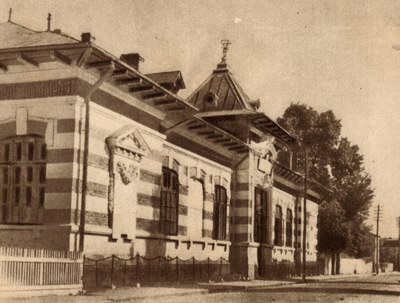Usually the narratives depict anything as an Israeli/Jewish conspiracy. But whose conspiracy Israel itself is? The official story talks about the mandate, the Balfour Declaration and various boring UN documents. But before all of that, there was a conspiracy, which occurred in… Romania. Specifically in places like Focșani, Iași, Cernăuți (now in Ukraine) and Chișinău.
Let’s go down the memory lane through a lesser known series of events that point to Israel’s Romanian roots.
First World Zionist Congress – Focșani 1881
Some 16 years prior to Theodor Herzl’s congress in Basel, delegates representing about 70,000 Jews from 33 places in Romania’s old kingdom, convened in Focșani and decided and managed to organize the first group of more than 200 emigrants to the Holy Land.
It was at this congress where Hatikvah was first sung.
This was happening in the closing days of 1881. No, seriously!
The venue was the Jewish Boys’ School in Focsani, built by banker Wilhelm Schleir who paid for everything from the construction itself to chalk and blackboards. The designer of the building was Ion Alexandru Davidescu, who designed most of the cute buildings that can still be admired today in Iași, Galați and Focșani.
Sadly, this particular building was demolished by the communists and replaced with a Brutalist/Soviet-style school which today serves as School number 9.
The Anthem of Israel is Romanian
Hatikvah, which today serves as Israel’s national anthem, is based on a Romanian folklore melody called Cucuruz cu frunza-n sus. Moreover, the lyrics were also written in Iași in preparation for the Zionist congress mentioned prior.
The author of the lyrics, Naftali Hertz Imber, remained in Iași for several years after fleeing Galicia in 1876 and was among those 200 who performed aliyah just a few weeks after the Focșani congress.
The final version of Hatikvah as we know it today, credited to Samuel Cohen, also happened in Iași and Mr. Cohen used as guidance a Romanian folklore book collected by Guilelm Șorban (1876-1923), a Jewish-Romanian composer with a Bohemian lifestyle.
We know all of these from his son, Raoul Șorban (1912-2006) who was a longtime art critic, painter, historian and memoirist. Yours truly had the privilege of knowing him in person in 2004.
The language issue was decided in Romania
If you visit the Museum of Bukovinian Jewish History and Culture in Chernivtsi/Cernăuți (today in Ukraine) you’ll find out several interesting things about the history of Israel.
Online you can find plenty of information about the 1908 Yiddish Language Conference (דער קאָנפֿערענץ פֿאָר יודישער שפּראַך) in Chernivtsi/Cernăuți which gave rise to the flourishing of literature written in Yiddish and ultimately to preserving the Yiddish language to this day.
However, there were other three Language conferences held in the 1920s in Cernăuți (then part of Romania) where the debates were less friendly than in 1908. The stakes were high: It was to be decided whether the Eastern European Jewry (which was most of the Jewry at the time) would join the idea of rebuilding the Hebrew language or stay out of it. The audio guide of the museum talks about getting the most stubborn delegates drunk in order for the motion to pass.
If that motion hadn’t passed, modern Israel may have ended up speaking Yiddish or Russian. In a way, that still happened, though.
Romanian language in Israel
Besides Hebrew, Arabic, Yiddish and English, there are two other languages that can frequently be encountered in Israel: Russian and Romanian.
Officially, there are about 100,000 Romanian speakers in Israel, but that figure only counts those who have or have had Romanian citizenship in the past. It does not count the descendants who routinely do speak Romanian as well, usually well-preserved with all of the archaisms that were typical when their (grand)parents left Romania. Former president of Israel, Reuven Rivlin, offered in 2021 the figure of 400,000 Romanian speakers in Israel which, although still under-counting, it’s closer to the truth, for sure.
It’s quite a pleasant surprise (for a language nerd like me) to talk to a 20 year old in 1920s Romanian – including phrasings that would be politically incorrect in present-day Romania – but those people don’t know that because while they’ve learned the language, many of them never visited Romania, let alone live here.
Also, given the consistent (and consistently growing) commercial and political ties between Romania and Israel, there is also a not-negligible number of Israeli citizens who speak some Romanian for these reasons.
Let’s put it this way: the president of the Jerusalem Academy of Music and Dance is born in Târgu Mureș. Her husband is King Bibi’s personal physician and is born in Târgu Lăpuș. Ariel Sharon spoke very good Romanian, having been married not once, but twice with Romanian women (two sisters from Brașov, seriously, look it up). The current minister of defense, Israel Katz, is, legally speaking, eligible for Romanian citizenship (both of his parents were from Maramureș).
Once you look into low-level politicians, there’s even more Romanian connections. The “early life” section of Israeli politicians almost always has either a Ukrainian or a Romanian connection. Which also explains the next one.
Uninterrupted recognition and diplomatic relations
After it turned out that Israel would not be a communist state, the relations between the USSR (and consequently the Warsaw Pact countries) and Israel got colder. And in 1967 the USSR ordered that everyone breaks diplomatic ties with Israel because the Israeli committed the unspeakable atrocity of not losing when all of the Arab world attacked them all at once. Even “worse”, they committed the sin of winning the Six Day War.
The Politburo thought this was absolutely haram and ordered that the Comecon (Warsaw Pact and friends) break diplomatic ties with Israel. And all did,… except Romania. Why would we break economic ties with our conspiracy?
Incidentally, this refusal in itself led to more antisemitic conspiracies in the USSR itself. Which led to more Soviet Jews wanting to leave but who now couldn’t leave because the destination, Israel, was no longer legally recognized by Moscow.
This state of affairs, of having only one communist state in Europe that recognized Israel, led to a de facto situation in which almost all negotiations between Israel and the communist world had to take place in Romania. And they did. This served Ceaușescu’s political goals and magalomania, but also served the diplomatic interests of both Israel and Romania (and still does, to this day).
Today, there is effectively one EU and NATO country that offers some recognition to “Palestine” while also not being at odds with Israel. Specifically, Romania recognizes the PLO as the legitimate representative of the philistines, but not any of their maps. It’s a classic Romanian diplomacy move of attempting to have the cake and eat it too – except in this case it’s been working really well.
There’s a Palestinian Embassy in Bucharest and most of the negotiations with “Palestine” effectively end up taking place in Romania, and in the process strengthening the case that Israel is a Romanian conspiracy since neither the West nor the philistines are happy with this arrangement, while Romania and Israel are okay with it.
Military, intelligence and commerce
The situation described above also allowed for a flourishing commercial and intelligence relationship between Romania and Israel.
Israel get to test a lot of the new toys in Ukraine by making them in Romania, with Romanian contractors. Legally, everyone gets what they want: Ukraine gets its weapons, Romania gets technology and a revived manufacturing industry and military industrial complex, Israel gets to play “neutral” and the Russians get blown up. Oh welp, I guess not everyone gets what they want, but still.
The largest arms exporter in Romania is Elbit, legally a Romanian-Israeli conglomerate, which owns 5 manufacturing facilities in Romania. Getting more accurate statistics is difficult because most Israeli investors do qualify for Romanian citizenship (as explained above) and they usually go for it in order to avoid having to comply with the increasingly onerous and anti-Israeli EU regulations.
In addition to military and intelligence, a lot of shekalim (literally, in this case) go through energy and tourism. It’s hard to explain to those not from around here just how big tourism is between Israel and Romania. There are more flights between Romania and Israel in most weeks than flights between Romania and France.
But no, seriously
While the claim in the headline is obviously tongue-in-cheek, the information provided above is also absolutely true and easily verifiable. And the information above is a big part of the explanation as to why you don’t get Israel obsessed weirdos in Romanian politics. Even the “far right” likes Israel here.
That’s not to say there isn’t legit antisemitism here. But even the local antisemitism is way different than the terminally online westoid version. This may sound like a joke, but in Romania even the antisemites are Zionist. Local antiemites are usually deeply religious and, as such, they do pilgrimage to the Holy Land (as do tens of thousands of Romanians every year) – and they prefer to visit the Holy Land as part of a safe and relatively civilized country, rather than one of the worst iterations of dar al Islam.
And therein lies the rub for the purveyors of anti-Israel narratives: Even the weirdest and most hateful Romanians are still Romanians – which means most will still ultimately prefer pretty much anything to dar al-Islam. The more enlightened of us also prefer our conspiracy to their conspiracy.
Last week Israel celebrated 77 years of existence, which I’m sure it has some spiritual meaning for the 37% of Europeans who affirm in surveys that they believe in numerology. Compared to numerology, Israel being a Romanian conspiracy is a far more reasonable belief. So, with this occasion, the Sofa wishes our conspiracy Israel a long and prosperous life! Maybe with better economics, at some point too 😀
Next time someone brings up Israeli conspiracies, let them know who’s really behind all of this. Naturally, we should share the “fault” with Ukraine and Poland, but that’s a story for another day when we’ll explain how you’re all living in Eastern Europe but you don’t know it yet.




